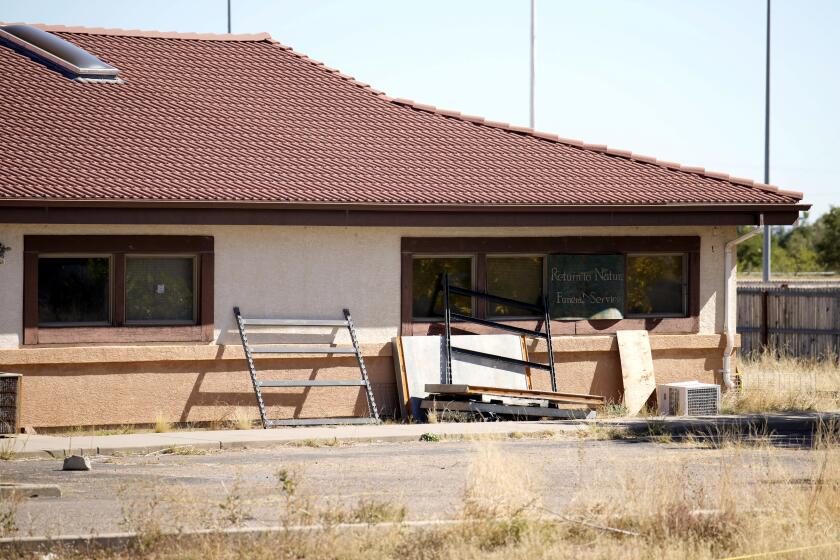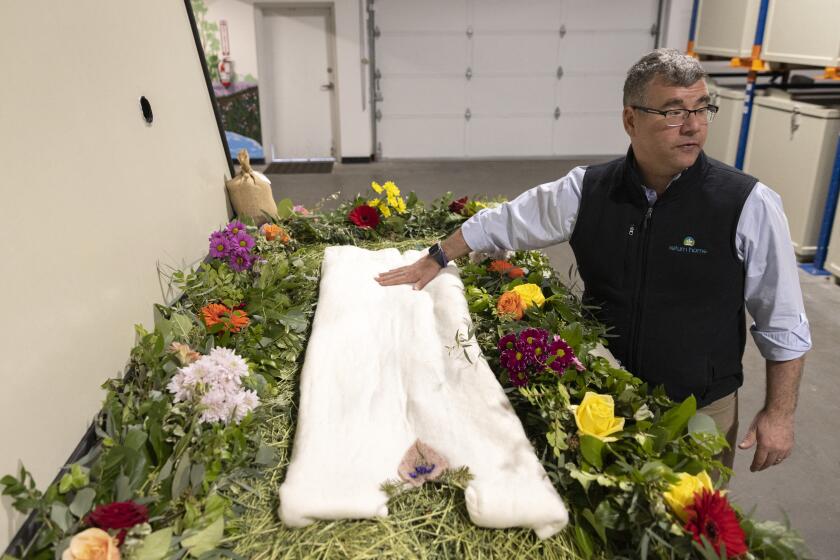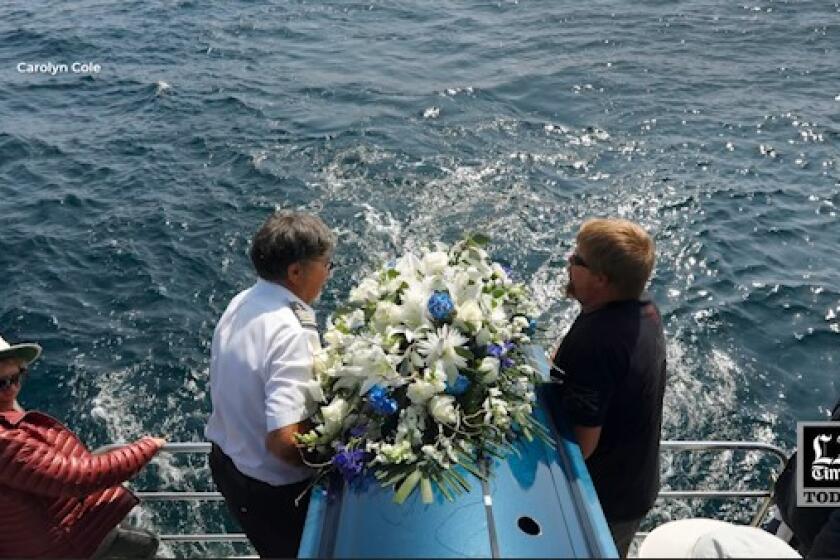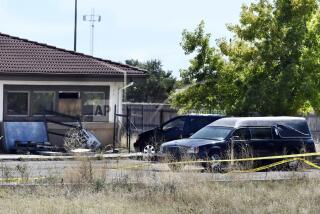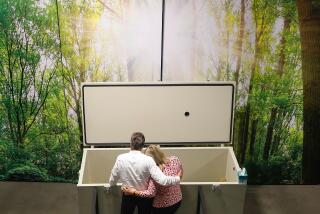Evidence suggests families received fake ashes from Colorado funeral home
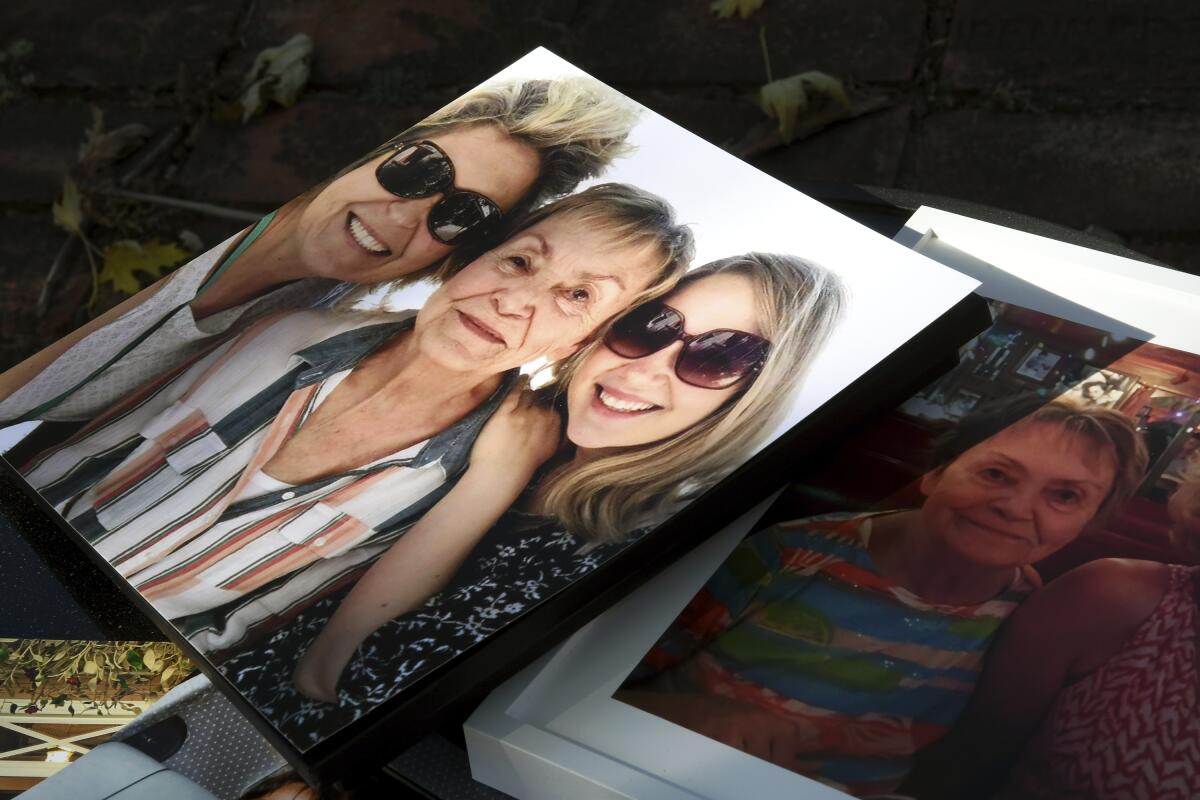
- Share via
COLORADO SPRINGS, Colo. — A Colorado funeral home where 189 decaying bodies were discovered this month appears to have fabricated cremation records and may have given families fake ashes, according to information gathered by the Associated Press from customers and crematories.
The families that did business with Return to Nature Funeral Home fear their loved ones weren’t cremated at all and instead could be among the yet unidentified corpses authorities discovered after responding to a report of an “abhorrent smell.”
“My mom’s last wish was for her remains to be scattered in a place she loved, not rotting away in a building,” said Tanya Wilson, who believes the ashes she spread in Hawaii in August were fake. “Any peace that we had, thinking that we honored her wishes, you know, was just completely ripped away from us.”
Return to Nature gave Wilson’s family and some others death certificates stating their loved ones’ remains had been handled by one of two crematories. But those businesses told the AP they were not performing cremations for Return to Nature on the dates noted on the certificates.
The remains of at least 189 people have been removed from a Colorado funeral home, up from an estimate of about 115 when the bodies were discovered.
Calls and text messages sent to numbers listed for Return to Nature and owners Jon and Carie Hallford have gone unanswered since the discovery of the decaying bodies. No arrests have been made. Law enforcement officials have said Return to Nature’s owners were cooperating as investigators sought to determine any criminal wrongdoing.
Numerous remains have been identified and notification of family members will begin soon, Fremont County Coroner Randy Keller said in a Thursday night statement. But he added that the identification process is becoming more complicated and could take months to complete.
The AP reviewed four death certificates provided by families. All list a crematory owned by Wilbert Funeral Services, but the deaths recorded in the certificates all occurred at least five months after the company stopped doing cremations for financially troubled Return to Nature last November. Lisa Epps, attorney for Wilbert, said members of at least 10 families told the company they had death certificates from after November.
A second crematory, Roselawn Funeral Home in Pueblo, Colo.,, was contacted by a family last week that had a 2021 death certificate from Return to Nature listing Roselawn as the crematory. Roselawn did not do the cremation, said its manager, Rudy Krasovec.
California lawmakers may soon legalize human composting as an alternative to casket burials and cremation.
None of the families the AP interviewed received an identification tag or certificate that experts say are usually given to ensure cremations are authentic. Members of all four families described a similar consistency of the ashes that seemed like dry concrete. Two mixed some ashes with water and said they solidified.
Dry concrete has been used before by funeral homes to mimic human ashes, including at another Colorado funeral home where the operators were accused of selling body parts and received lengthy federal prison sentences for mail fraud. Attorney Dave TeSelle is representing families in that case and said the AP’s findings were “exactly the type and pieces of evidence” that point toward fake ashes.
Stephanie Ford said her husband had nightmares of waking up in a coffin and hated the idea of being buried, his body decaying, so he asked to be cremated.
Wesley Ford died in April. Return to Nature handled the cremation and when Stephanie Ford learned of the grim discovery at the funeral home this month, her daughter, a physician, took a closer look at the ashes.
“Mom, that’s not Dad,” she told her mother.
Funeral homes seek to legalize ‘bio-cremation’ as a green alternative
“I know logically it’s not my fault,” said Stephanie Ford, pushing the words through tears. “There’s a little bit of guilt on my part that I let him down.”
The Hallfords and their company, which opened in 2017 and offered cremations and “green” burials without embalming fluids, were beset by recent financial and legal troubles, public documents show. Among the problems were a forced eviction, unpaid taxes and a lawsuit by Wilbert, which received a $21,000 judgment in June because Return to Nature failed to pay for “a couple hundred” cremations, Epps said.
The couple had claimed they would settle up their rent when they got paid for work they had done for the Federal Emergency Management Agency during the COVID-19 pandemic, according to their former landlord, and the funeral home website featured the logos for FEMA and the Department of Defense.
FEMA did not have any contracts with the funeral home, the agency said Friday. A Defense Department database search also showed no contracts with the funeral home.
When Return to Nature gave ashes to Tanya Wilson’s family, her brother thought they were unusually heavy and confronted Carie Hallford about his concerns.
“Jesse, of course, this is your mother,” Elliott recalled Hallford saying.
With both siblings skeptical, Wilson took some of the ashes to another funeral home for a second opinion. Platt’s Funeral Home director Amber Flickinger told the AP that the ashes were unusually fine and dark, adding, “I’ve never seen anything that looks like that in the range of what cremated remains would typically expect to look like.”
Another woman, Michelle Johnston, became skeptical that the ashes she received were of her husband, Ken, a retired UPS driver. She mixed ashes with water and it looked like concrete, she said.
“I was kind of getting to a place where I wasn’t losing it every day,” she said, and now, “I don’t know where my husband is.”
Proper cremations produce bone fragments without any organic material, which means no DNA that could be used to identify individuals, said Barbara Kemmis, executive director of the Cremation Assn. of North America. Sometimes RNA is preserved and that can distinguish if the ashes are from a male or female, and if they are human or from another animal, she said.
Determining fakes can be more straightforward, particularly if they are concrete. A simple test entails wetting the material and seeing if it hardens when it dries. Real ashes would not be expected to transform into a solid object and would stay brittle, said Faith Haug, who chairs the mortuary science program at Colorado’s Arapahoe Community College.
Gov. Gavin Newsom signs Assembly Bill 351, which legalizes an alternative burial method known as human composting.
Authorities could be waiting to bring charges in the case until they determine if there are more bodies, said Ian Farrell, a criminal law expert at the University of Denver Sturm College of Law.
Potential charges under state law could include misdemeanor violations of mortuary regulations and misdemeanor fraud, he said. Each body could result in separate charges, meaning potential fines topping $1 million. The maximum consecutive sentence for misdemeanors is two years in jail, he said.
Potential penalties from federal charges could be more severe.
Abby Swoveland hired Return to Nature when her mother passed away. Sally Swoveland had run a muzzleloader gun shop called the Mountain Man for nearly 50 years.
When Abby Swoveland called Wilbert Funeral Services, listed on the death certificate, and learned they had long ago stopped doing business with Return to Nature, she was devastated.
“It completely has undone any healing that was taking place,” Swoveland said.
Associated Press writers Thomas Peipert in Colorado Springs and Amy Beth Hanson in Helena, Mont., contributed to this report .
More to Read
Sign up for Essential California
The most important California stories and recommendations in your inbox every morning.
You may occasionally receive promotional content from the Los Angeles Times.
